Religious, political, socioeconomic, cultural and dietary contexts, not to mention the natural environment, have undeniably influenced the evolution of food practices and choices; the same is true of fads and “taste trends.” These processes mainly revolve around cooking fats as they affect both cooking techniques and seasoning, while often providing an identity as well. Analyzing them over long time periods, using recipe books in particular, we find that fats are highly significant foods. They have played an important role in the history of cooking, as well as in changes to tastes. This is the case with butter and its “true history.”
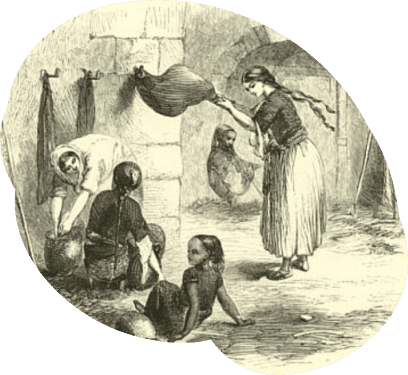 Egyptian Women Churning Butter, Proverbs, xxx, 33. Illustration for
Egyptian Women Churning Butter, Proverbs, xxx, 33. Illustration forButter is almost always used in refined and gourmet recipes. Until the fifteenth century, animal fats and olive oil were mainly used for cooking in Europe and around the world. However, historians have noted references to butter in Tibet and India for use in religious ceremonies, in China during the Tang Dynasty, and in the distant lands of Siberia as an invigorating drink. The Irish, the Scots and the Scandinavians used to be buried with a barrel of butter. Many beliefs of northern European countries endow butter with health benefits and curative properties, certainly due to the Vitamin A it contains.
During the Middle Ages, though butter sometimes appeared in culinary books, it is seen in only 2% of the Viandier recipes, written by Guillaume Tirel (Taillevent), the celebrated cook of kings Charles V and Charles VI. It was not until the fifteenth century that Italy adopted butter in its culinary vocabulary and that the expression “browning” became commonly used. The Age of Enlightenment in France shook the whole of Europe and turned eating habits and the ritual of meals upside down through the invention of new techniques and utensils. Pats of butter were sometimes stamped or hand-decorated using a spoon or a kind of spatula; they were sometimes open molded, piston-molded or shaped in tannin-free woods such as linden, plane or beech. Butter moulds are often decorated with engravings illustrating the region of origin, the initials of the farm owner or natural scenes. In the countryside and at markets the pats were sometimes simply wrapped in cabbage leaves. In aristocratic mansions, the butter dish has maintained its place on the most beautiful tables since the 18th century.
 Butter making woman from the Compost et Kalendrier des Bergères,
Butter making woman from the Compost et Kalendrier des Bergères,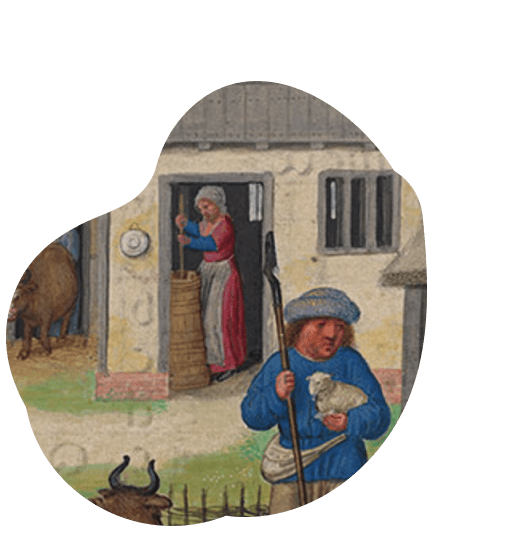 Simon Bening, The Da Costa Book of Hours, 1515, Morgan Library
Simon Bening, The Da Costa Book of Hours, 1515, Morgan Library
Cooking with butter appeared in the 15th century and made a remarkable entrance into treatises on cooking during the Renaissance. Butter became the favorite fat for making “roux,” the new binding technique that would replace Medieval practices using bread. Only white butter and browned butter were used at the time, “black butter” came along much later. “Butter and lard are the most commonly used fats in the cuisine of the Enlightenment, far more than scarce olive oil in the kitchens of the Grand Siècle, with the exception of the Mediterranean world” according to Patrick Rambourg, a historian and researcher specialising in cooking and gastronomy. Flavors were becoming more and more subtle.
Delicate aromas take over thick sauces, and garnishes are more refined. Puff pastry and other pastries made their appearance on elegant tables in the Kingdom of France and the Courts of Europe. Creating recipes becomes an aristocratic pastime, Louis XV, Madame de Pompadour and the famous Countess du Barry have all entered dishes into the culinary heritage! Butter, an essential ingredient of these culinary upheavals, became the symbol of luxury, elegance and refinement.
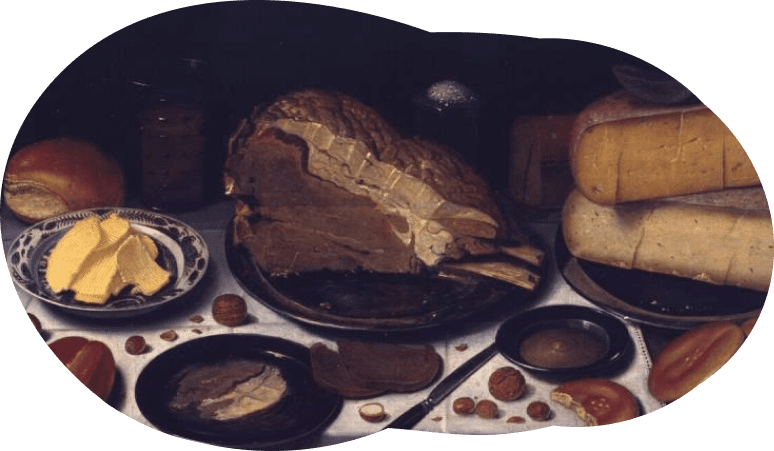 Floris van Schooten, Breakfast c. 1615, Kröller-Müller Museum
Floris van Schooten, Breakfast c. 1615, Kröller-Müller Museum
The emergence of butter in the culinary world was also partly related to its use on Fridays, Saturdays and Wednesdays, i.e. on days when Christians could not eat meat (not for dietary reasons but because animal flesh was considered to be a “hot” food, creating vice). The Church, which banned the consumption of animal fat during Lent, as well as during lean days, ended up allowing the consumption of butter. This dispensation would play an important role in the evolution of this fat, which was now used on a daily basis and would go on to become a staple of cooking. It is interesting to note that it became the fat used in “low-fat” recipes and to prepare fish dishes on “fish days”. Religious dictates would therefore influence the choice of fats used in the kitchen, but the taste for butter was never lost. Some butters are sought after for their aroma and flavor, others for their delicacy and beautiful color, and others because they are produced in spring and autumn …
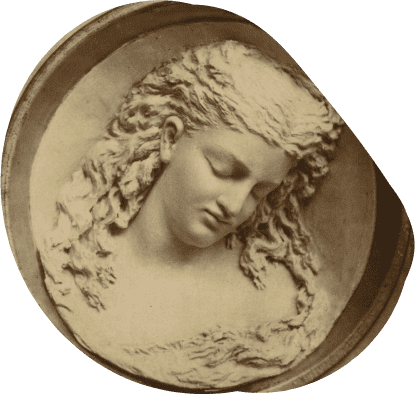
Subsequently, during the nineteenth century and a good part of the twentieth, of the three main fats – lard, oil and butter – butter became the essential fat used in French cuisine. Scientific studies have shown that fatty acids contribute to the proper functioning of the body, although they must be consumed in a balanced way. The dogma of good and bad fats and their demonization has happily vanished.
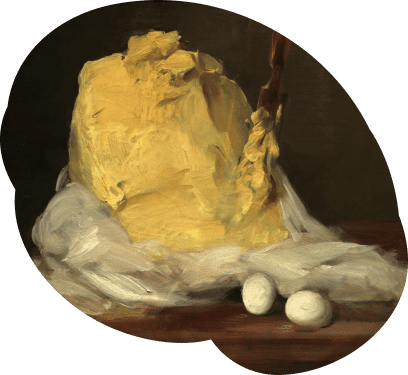 Motte de Beurre, Antoine Vollon, c.1880, National Gallery of Art
Motte de Beurre, Antoine Vollon, c.1880, National Gallery of Art
For their part, chefs are reintroducing butter into the kitchen for its flavor, its creaminess and the cooking techniques it enables. Raw or browned, butter can also be clarified to cook without browning and to enable prolonged cooking. This is known as Smen in the Maghreb, Samnah in the Middle East, Ghee in India, Manteiga de Garrafa in Brazil, and Mantequilla Clarificada in Spanish. For nearly five millennia, butter has been used in purification rituals, in anti-wrinkle ointments, in foundation make-up for traditional festivals, as a lucky gift in ceremonies and as a cure for burns and eye conditions. But especially now, butter plays a role as a luxury ingredient in gourmet cooking.
This cultural heritage can still be enjoyed today in all European countries, from gnocchi with sage butter in Tuscany to the many variations of Belgian waffles, as well as Spanish sobaos and koulourakia biscuits made in Greece over the koulourakia period. We will end his ode to butter with an incantation used by the peoples of Northern Europe, the Celts, the Vikings and the Icelandic people to protect their butter.